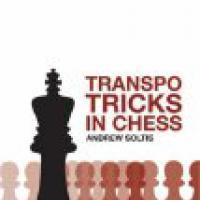
Transpositions
"The other day someone was talking about how an opening I played "transposed" to another opening. What does this mean?"
Dear Reader,
Transposition is one of the easier concepts in chess and yet it can be really painful if you do not understand it. Today we will help you on that front with some basic principles in openings that will help you understand transpositions in a much better way.
Let me begin with the simplest explanation of transpositions. Transpositions are the possibility to reach a particular opening position using a different move order. For example, take a look at this simple transposition.
This end position can be achieved through two different simple move orders. The main line being the Slav Defense from the Queen's Gambit Declined variation and the variation shown started as the English opening and then transposed into the main line.
I am sure this example is very easy to understand, but opening transpositions that can arise after some depth of moves can be quite confusing unless the player understands the game properly. Before we go on studying transpositions, let us try and answer the basic question of why do we care to know about it? Basically, being able to identify a position from a different opening and understanding the resemblance of the position with another opening helps you plan better. In simpler words, you do not have to reinvent the wheel. Known ideas, known threats and known traps are just going to make your play much more comfortable. Having said that, it is not impossible to play a good game without understanding the transpositions, it is just inefficient.
Now let me explain the key ideas that one needs to understand to be able to recognize such transpositions. Study the pawn structures thoroughly and try to understand the opening variation in terms of these pawn formations rather than just the move order. The following example should help you understand my point precisely.
Let us examine the following position. White has traded his 'e' pawn for black's 'c' pawn. They both have centralized pawns on the 'd' file and lastly white is challenging the central 'd' pawn with his 'c' pawn. This pawn formation can arise out of several move orders. For example
The same position arises out of the Caro-Kann defense or the Scandinavian defense (aka Center-Counter) or the English opening. It does not matter what move order you followed to reach this position since that is insignificant from this point forward. It is not the exact move order, but the way the pawns are positioned that should help you form your plans. If you know your plan here, that will automatically help you play well in all of the above-mentioned openings (Of course, only these particular variations!).
Our next example is going to be a little deeper. Take a look at the two possible variation from the game below. They both reach the same middle game position, however they started out as very different openings. The king pawn and queen pawn opening in chess are considered to be very different in their nature of play, but this position should help you understand that there is always a possibility of one transposing into the other.
The way you can identify this transposition is by closely following the transformations of the pawn structure. In both cases white ended up with an isolated pawn in the center after a couple of pawn trades. It really does not matter how those pawns are traded as long as white has the isolated center pawn.
Our last example of the day will very much demonstrate the importance of understanding pawn formations in chess. Let us take the position from the Panov Botvinnik in the earlier examples and make a minor change to it. Lets say, white chose to play 4.c3 instead of 4.c4 and black eventually responds with e6. Then you will have the following position.
Does this pawn formation ring a bell? You can obviously think through the possibilities and come out with the best plan based on your level of play, but it would be much easier if you knew some ideas that are established, isn't it?
Here is a position that arises out of the Queen's Gambit declined and white uses the famous minority attack on black's queen side. One of white's plans would be to push his 'a' and 'b' pawns all the way down to try and create weakness in black's queen side. The idea gets its name from the fact that white uses two pawns to attack black's three pawns in the queen side.
Now, go back and take a look at the previous position where white played c3 and black played e6. The pawn structures are exactly the same, but the colors are reversed. If you recognize this one, then it would be easier for you to plan your middle game. That is of course assuming you have some idea about the opening to begin with!
To conclude our answer, pawn structures are the key to understanding transpositions. The more openings pawn formations you know, the more time you save over the board by not trying to figure out new plans in new positions.
Have a question? Email it to Magesh and Arun via [email protected] and they may answer it in a future column!



